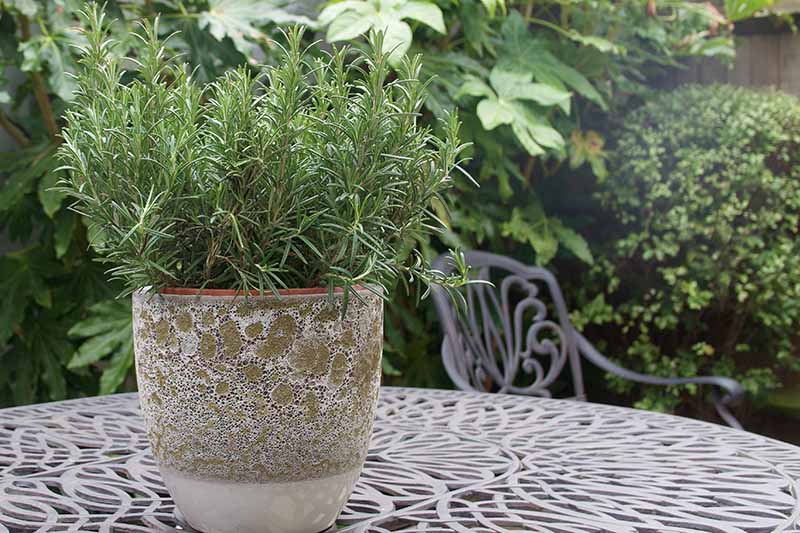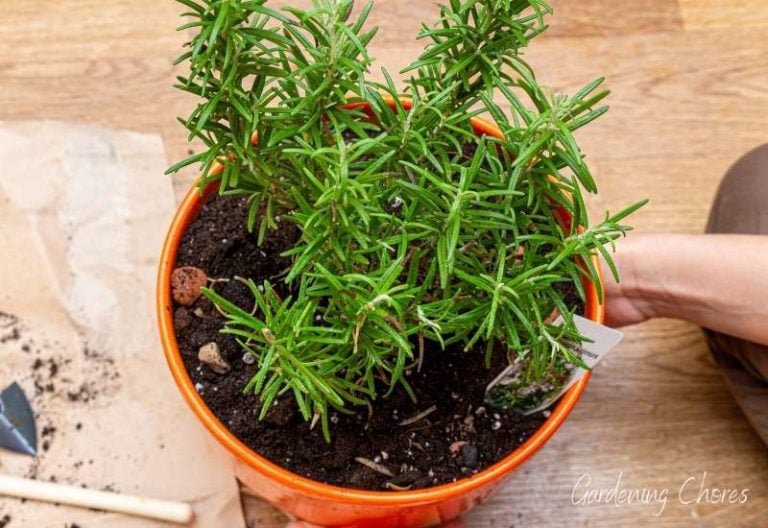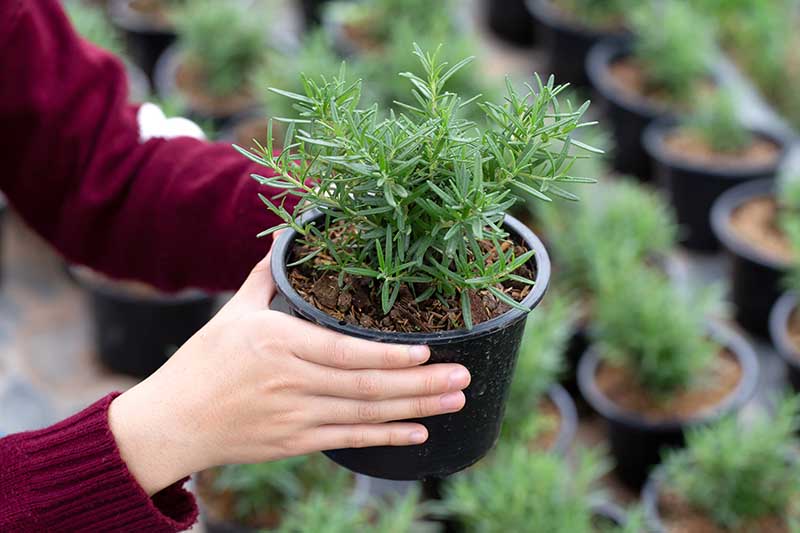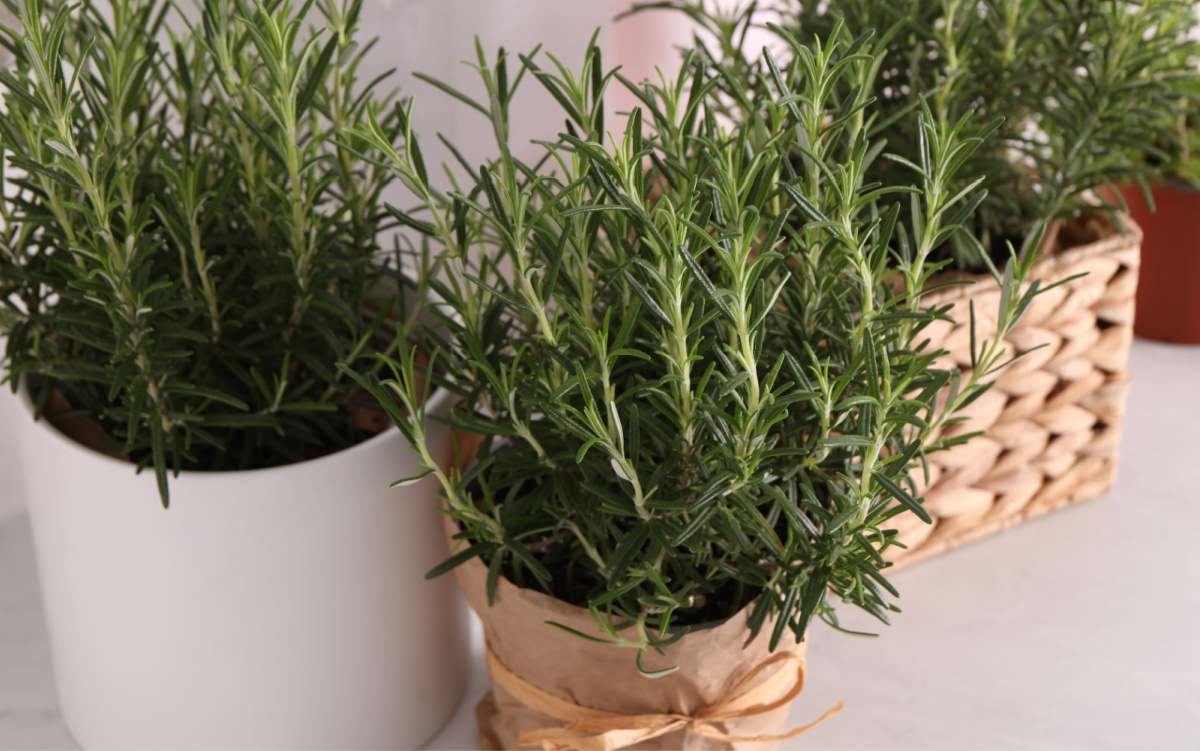Choosing the Right Pot and Soil for Rosemary
When it comes to growing rosemary in a pot, selecting the right container and soil is crucial for the plant’s success. Rosemary requires a pot with good drainage to prevent waterlogged soil and root rot. A pot with drainage holes in the bottom will help to prevent water from accumulating in the soil. Additionally, a well-draining potting mix is essential to prevent the soil from becoming too wet. A mix specifically designed for herbs or Mediterranean plants is ideal, as it will be formulated to drain excess water quickly.
When choosing a pot, consider the size. Rosemary has a deep taproot, so a pot that is at least 6-8 inches deep is recommended. This will give the roots room to grow and help to prevent the plant from becoming pot-bound. A pot that is too small can cause the roots to become tangled and reduce the plant’s ability to absorb nutrients.
In terms of material, a terra cotta or ceramic pot is a good choice. These materials allow for good air circulation and can help to prevent the soil from becoming too wet. Avoid using plastic pots, as they can retain too much moisture and cause the roots to rot.
By choosing the right pot and soil, you will be well on your way to growing healthy and fragrant rosemary in a pot. Remember to also consider the plant’s lighting and temperature requirements, as well as its watering and fertilization needs, to ensure optimal growth.
For those looking to learn how to grow rosemary in a pot, it’s essential to understand the importance of proper soil and container selection. By following these tips, you can create a thriving environment for your rosemary plant to grow and flourish.
Understanding Rosemary’s Lighting and Temperature Requirements
Rosemary is a Mediterranean herb that thrives in warm, sunny conditions. When growing rosemary in a pot, it’s essential to provide the right amount of light and temperature to promote healthy growth. Rosemary prefers full sun to partial shade, making it an ideal candidate for a south-facing windowsill or a sunny patio.
In terms of temperature, rosemary prefers daytime temperatures between 65-75°F (18-24°C) and nighttime temperatures around 55-65°F (13-18°C). Avoid placing the pot near heating or cooling vents, fireplaces, or drafty windows, as this can cause temperature fluctuations that may stress the plant.
During the winter months, rosemary may require supplemental lighting to maintain its health. Consider using grow lights or placing the pot near a sunny window to provide the necessary light. Aim to provide at least 4-6 hours of direct sunlight or 12-14 hours of indirect sunlight per day.
When learning how to grow rosemary in a pot, it’s crucial to understand the importance of proper lighting and temperature. By providing the right conditions, you can encourage healthy growth, prevent disease, and promote a robust flavor and aroma.
Some tips to keep in mind when providing light and temperature for your rosemary plant include:
- East- or west-facing windows are ideal for rosemary, as they provide gentle, indirect light.
- Avoid placing rosemary in areas with high humidity, as this can lead to root rot and other diseases.
- Monitor the temperature and adjust the pot’s location as needed to maintain the optimal range.
By following these guidelines, you can create a thriving environment for your rosemary plant to grow and flourish.
Watering and Humidity: The Key to Healthy Rosemary
Watering and humidity are crucial factors to consider when learning how to grow rosemary in a pot. Rosemary requires consistent moisture, but it’s also susceptible to root rot if the soil is too wet. To avoid this, it’s essential to water rosemary carefully and maintain a humid microclimate around the plant.
Check the soil moisture by inserting your finger into the soil up to the first knuckle. If the top inch of soil feels dry, it’s time to water. Water rosemary thoroughly, making sure the pot drains well to prevent waterlogged soil. Avoid getting water on the leaves or crown of the plant, as this can cause rot and other diseases.
To maintain a humid microclimate, place the pot on a tray filled with water and pebbles. As the water evaporates, it will create a humid environment around the plant, which will help to prevent dryness and promote healthy growth. You can also use a humidifier or group plants together to create a microclimate.
Some tips to keep in mind when watering and maintaining humidity for your rosemary plant include:
- Avoid watering rosemary in the evening, as this can encourage fungal growth and other diseases.
- Use room-temperature water, as cold water can shock the roots and cause stress to the plant.
- Monitor the humidity levels around your rosemary plant, and adjust the tray or humidifier as needed to maintain a humid microclimate.
By following these guidelines, you can create a healthy and thriving environment for your rosemary plant to grow and flourish.
Remember, when learning how to grow rosemary in a pot, it’s essential to consider the specific needs of the plant, including watering and humidity. By providing the right conditions, you can promote healthy growth, prevent disease, and enjoy the many benefits of this fragrant and versatile herb.
Fertilizing Rosemary for Optimal Growth
Fertilizing rosemary is an essential step in promoting healthy growth and maximizing its fragrance and flavor. When learning how to grow rosemary in a pot, it’s crucial to understand the importance of fertilization and how to do it correctly.
Rosemary is a Mediterranean herb that thrives in well-draining soil with a slightly acidic pH. To promote optimal growth, use a balanced, water-soluble fertilizer during the growing season (spring-fall). A fertilizer with a ratio of 20-20-20 (nitrogen-phosphorus-potassium) is ideal, as it provides equal amounts of each nutrient.
However, it’s essential to dilute the fertilizer to half the recommended strength to prevent burning the roots. Rosemary is sensitive to over-fertilization, which can cause more harm than good. Start with a weak solution and gradually increase the strength as the plant grows.
Some tips to keep in mind when fertilizing rosemary include:
- Avoid fertilizing rosemary during the winter months, as this can cause the plant to produce new growth that may be damaged by frost.
- Use a fertilizer that is specifically formulated for herbs or Mediterranean plants, as these products are designed to meet the unique needs of these plants.
- Monitor the plant’s response to fertilization and adjust the frequency and strength of the fertilizer as needed.
By fertilizing rosemary correctly, you can promote healthy growth, maximize its fragrance and flavor, and enjoy the many benefits of this versatile herb.
Remember, when learning how to grow rosemary in a pot, it’s essential to consider the specific needs of the plant, including fertilization. By providing the right nutrients, you can create a thriving environment for your rosemary plant to grow and flourish.
Pruning and Training Rosemary for a Bushy Shape
Pruning and training are essential steps in maintaining a healthy and bushy rosemary plant. When learning how to grow rosemary in a pot, it’s crucial to understand the importance of regular pruning and training to promote healthy growth and prevent the plant from becoming leggy.
Rosemary is a naturally upright plant that can grow quite tall if not pruned regularly. To maintain a bushy shape, pinch off the flower buds as they form. This will direct the plant’s energy towards leaf growth and prevent it from flowering. Pinching off the flower buds will also encourage the plant to produce more stems and leaves, resulting in a fuller and more compact plant.
In addition to pinching off flower buds, trim back leggy stems to encourage branching. Cut back the stems to about half their length, making sure to cut just above a node (where a leaf meets the stem). This will encourage the plant to produce new growth and prevent it from becoming too leggy.
Some tips to keep in mind when pruning and training rosemary include:
- Prune rosemary regularly to maintain its shape and promote healthy growth.
- Use sharp, clean pruning tools to prevent spreading diseases and damaging the plant.
- Make clean cuts just above a node to encourage new growth and prevent the plant from becoming too leggy.
By pruning and training rosemary regularly, you can maintain a healthy and bushy plant that will provide you with fresh rosemary leaves and stems for cooking, herbal remedies, and crafts.
Remember, when learning how to grow rosemary in a pot, it’s essential to consider the specific needs of the plant, including pruning and training. By providing the right care and attention, you can create a thriving environment for your rosemary plant to grow and flourish.
Pest and Disease Management for Container-Grown Rosemary
Container-grown rosemary is susceptible to various pests and diseases that can affect its health and productivity. When learning how to grow rosemary in a pot, it’s essential to be aware of these potential issues and take steps to prevent and manage them.
Common pests that can affect rosemary in containers include spider mites, mealybugs, and aphids. These pests can cause damage to the leaves and stems, and can also transmit diseases to the plant. To manage these pests, inspect the plant regularly and use organic pest control methods such as neem oil or insecticidal soap.
Rosemary is also susceptible to various diseases, including root rot, leaf spot, and powdery mildew. These diseases can be caused by overwatering, poor air circulation, and high humidity. To prevent these diseases, make sure to provide good air circulation around the plant, avoid overwatering, and treat fungal diseases with fungicides.
Some tips to keep in mind when managing pests and diseases in container-grown rosemary include:
- Inspect the plant regularly for signs of pests or diseases.
- Use organic pest control methods whenever possible.
- Provide good air circulation around the plant to prevent fungal diseases.
- Avoid overwatering, which can lead to root rot and other diseases.
By being aware of the potential pests and diseases that can affect container-grown rosemary, you can take steps to prevent and manage them, and keep your plant healthy and productive.
Remember, when learning how to grow rosemary in a pot, it’s essential to consider the specific needs of the plant, including pest and disease management. By providing the right care and attention, you can create a thriving environment for your rosemary plant to grow and flourish.
Repotting Rosemary: When and How to Do It
Repotting rosemary is an essential step in maintaining its health and promoting new growth. When learning how to grow rosemary in a pot, it’s crucial to understand when and how to repot the plant to ensure its continued success.
Rosemary typically needs to be repotted every 1-2 years, as its roots can become pot-bound and the soil can become depleted of nutrients. To determine if your rosemary plant needs to be repotted, check the roots by gently removing the plant from its pot. If the roots have filled the pot and are circling around the inside, it’s time to repot.
When repotting rosemary, choose a pot that is only 1-2 sizes larger than the original one. This will give the roots room to grow without becoming too wet or waterlogged. Use a well-draining potting mix and a pot with good drainage holes to prevent water from accumulating in the soil.
When handling the roots during repotting, be gentle and avoid damaging them. If the roots are circling around the inside of the pot, use a fork or your fingers to gently tease them apart. This will help to prevent the roots from becoming tangled and promote healthy growth.
Some tips to keep in mind when repotting rosemary include:
- Repot rosemary in the spring or summer, when the plant is actively growing.
- Use a pot that is only 1-2 sizes larger than the original one to prevent the soil from becoming too wet.
- Handle the roots gently during repotting to avoid damaging them.
By repotting rosemary regularly, you can provide the plant with the nutrients and space it needs to thrive. This will help to promote healthy growth, prevent disease, and ensure a bountiful harvest of fresh rosemary leaves and stems.
Remember, when learning how to grow rosemary in a pot, it’s essential to consider the specific needs of the plant, including repotting. By providing the right care and attention, you can create a thriving environment for your rosemary plant to grow and flourish.
Harvesting and Using Fresh Rosemary from Your Container Garden
Once rosemary is established in a pot, it can be harvested at any time, providing a continuous supply of fresh leaves and stems for various uses. To harvest, simply pinch or cut off the desired amount of rosemary, making sure to leave enough for the plant to continue growing. Regular harvesting encourages bushy growth and prevents the plant from becoming leggy.
Rosemary is a versatile herb that can be used in a variety of dishes, from roasted meats and vegetables to soups, stews, and breads. It pairs well with olive oil, garlic, and lemon, and can be used to make herbal teas, marinades, and sauces. Fresh rosemary can also be used in herbal remedies, such as infusions and salves, to promote digestion, relieve stress, and improve mental clarity.
In addition to its culinary and medicinal uses, rosemary can be used in crafts and decorative arrangements. Fresh rosemary sprigs can be used in wreaths, potpourri, and other floral arrangements, while dried rosemary can be used in sachets, wreaths, and other decorative items.
To dry rosemary for later use, tie the stems in small bunches and hang them upside down in a warm, dry, dark place. Once the rosemary is completely dry, remove the leaves from the stems and store them in airtight containers. Dried rosemary can be used in cooking, herbal remedies, and crafts, and can be stored for up to six months.
For those who want to preserve rosemary for longer periods, freezing is a great option. Simply chop the fresh rosemary leaves and place them in a single layer on a baking sheet. Once frozen, transfer the rosemary to airtight containers or freezer bags and store in the freezer for up to one year. Frozen rosemary is perfect for adding to soups, stews, and casseroles, and can be used in place of fresh rosemary in most recipes.
By following these simple steps, you can enjoy a continuous supply of fresh rosemary from your container garden, and make the most of this fragrant and versatile herb. Whether you use it in cooking, herbal remedies, or crafts, rosemary is a great addition to any garden, and can be easily grown and harvested in a pot.








